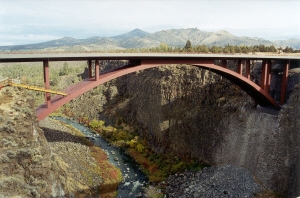CROOKED RIVER BRIDGE
TERREBONNE, OREGON
|
Crooked River Bridge is the first High Gorge Cast-in-Place Segmental Arch Bridge ever built in the US. It spans the dramatic basalt Crooked River Gorge, 300 feet above the river, with a concrete arch span of 410 feet. The bridge, located about 10 miles north of Redmond on US Highway 97, is 535 feet long and 79 feet wide. Began in 1996 the concept included cable-stayed construction and use of segmental travelers. Although both are relatively common, they had never before been combined on a high arch bridge in the US. The unusual engineering solution responded to the complexity of the site, whose vertical sides precluded traditional formwork. During construction, 185-foot-tall stay towers were erected on both rims of the gorge, which is 410 feet wide. Steel cables suspended the segmental travelers as each segment was cast, moving from the canyon rims toward the center. The18.3 million dollar arch was a marvel of engineering from the beginning of its construction, when the stay towers held sections of the bridge hanging improbably over the yawning gorge that finally met at the center within one inch of allowed tolerances. Only then were the towers and cables removed. . More than 7,860 cubic yards of concrete - the equivalent of 1,000 concrete mixer loads - were used to construct the fabulous bridge. It is reinforced with one-inch rebar that, if placed end to end would stretch from Memphis, Tennessee, to Little Rock, Arkansas, or if you are more familiar with distances in the east, from Bangor to Portland in Maine, a mere 132 miles. The structure was built in 28 x 43-ft segments that support a concrete box girder 79 feet wide and 5 ft - 6 in deep and spans 53 feet between spandrel columns. Visualize wet sloppy concrete poured in place 300 feet above a river bed. I think it is amazing, but I remain amazed at the engineering of the ancient Asians, Egyptians, Incas and Aztecs, as well, so I can see that our present generation has great genes from which to draw. The bridge is painted to blend with nature's high desert palette. The box is burnt brown, the arch and columns a rust-red, and abutments a rock-colored gray. Of course none of which can be seen if the traveler does not turn into the Crooked River Historic Landmark at the south end of the bridge. The High Bridge, built in 1926, is retained as a pedestrian and bicycle crossing from which to view the awesome construction as well as the railroad steel bridge arch built in 1910. Never mind looking down into the gorge itself and wonder what the Native Peoples thought of its creation or the smoke signals that spoke between Tribes for centuries. Peter Skene Ogden was a fur trapper and explorer for Hudson's Bay Company who reported the Crooked river in 1826 had no beaver. A plaque on a column of the historic High Bridge bears his connection to Oregon, settling into community life in Oregon City, where he died in 1854. I drove on US 97 in 1997 when conceptual drawings were displayed at the Ogden Wayside Rest Area and was caught up in what appeared to be engineering genius. On September 5, 2005, I was delighted to view the completed bridge and the columns with plaques commemorating the bridges' histories. Sagebrush and green and gray rabbitbrush were in bloom, enhancing the desert panorama. This newest bridge in the gorge's trio of spans is now labeled the Rex T. Barber Veterans Memorial Bridge with a plaque describing his dogged feat of shooting down the plane carrying the Japanese mastermind of the Pearl Harbor disaster. We are great for labels, we Americans, for good or not. |
Award for outstanding concrete bridge.
View of the completed cast-in-place span
from the Historic High Bridge of 1926
The longest steel bridge in the western hemisphere
was built in West Virginia in 1977.
It is featured on the West Virginia state quarter.
Copyright 1997 - 2005
SalmonRiverPublishing
